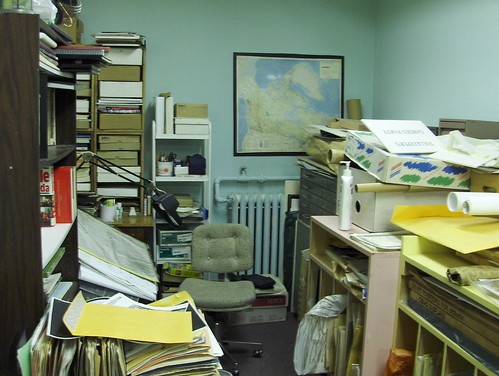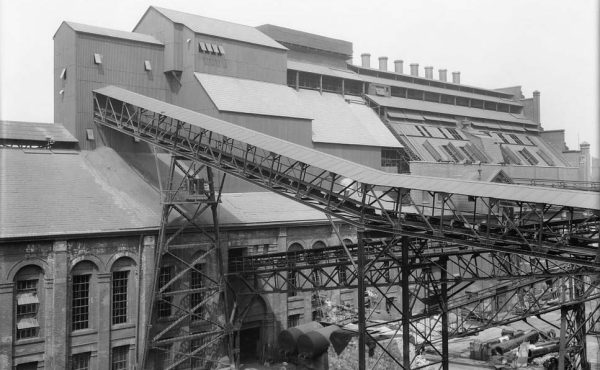
ED: This entry was posted last Friday — we’ve been informed that the Community History Project is still looking for space this week, though there have been some leads. As some people may have been on vacation last week, we’ll bring this entry to the top as it may reach to somebody with space-to-give who missed it the first time.
Much has been written about the southeast corner of Yonge and Bloor and the planned 80-storey 1 Bloor development that will remove the existing buildings on the site. While we lamented the loss of the interesting public space offered by Roy’s Square in the previous issue of Spacing, there could not be a more appropriate location in Toronto for a supertall building. Invoking Toronto’s traditional (and fading) fear of heights here likely makes it more difficult to oppose inappropriate developments elsewhere (the-boy-who-cried-skyscraper syndrome). Lost in the shuffle, however, are the small, independent businesses that will be displaced. Hidden, but equally important in locations like this, are the cheap office spaces found on the upper levels that house a variety of small operations.

One such organization thrown into crisis by the 1 Bloor development is the Community History Project. Founded in 1983 as an all-volunteer local history group, they have been housed on the 2nd Floor of 719 Yonge since 1996 in space donated by the building’s civic-minded owner. Inside three packed rooms, shelves and filing cabinets (43 in all) overflow with Toronto history gathered around the project’s “study area” — roughly the Don River to Dufferin, Wellesley up to St. Clair. Plans and artifacts from their biggest ongoing project, the restoration of the Tollkeepers Cottage at Bathurst and Davenport, are also found throughout the room. The office also serves as a meeting space for the group and other affiliated organizations, and houses their research library.

As mentioned in the Toronto Heritage Awards post back in October, organizations like this are what have made Toronto great. Independent citizens working together, often using their own money, to preserve and protect chunks of Toronto that otherwise might be forgotten as they have in cities without such active citizens. With only two weeks before eviction, The Community History project needs your help in finding a new home. If you know of a civic minded landlord who has extra office space and is interested in “giving back to the community” in a unique way, please pass this post on to them — space for the group may be found in the most unexpected of places, so please spread this request far and wide. The group needs approximately 2500 square feet of heated space that is publicly accessible and has access to water. Any tips or suggestions can be given ASAP directly the project at 416-515-7546 (they will be keeping their phone line operationally as long as they can — if you can’t reach them, post a comment here or email us and we’ll get in touch with them).




17 comments
I was going to suggest the following admitted way-long shot: have you considered contacting Roger Keil of York University’s City Institute to see if he can steward something through at York? It seems like those people have new funding and space and lots of backing from York — and York itself has been active lately in attracting related space-needing things like the Archives of Ontario, along with Holocaust memoir archives, Mariposa Folk Fest archives.
But I see the study area starts only at St. Clair. So maybe this is not so appropriate a suggestion. Still, in case it’s at all relevant…
I live in the Junction, and there are quite a few spaces which remain for rent along Dundas, and the area is undergoing quite the rejuvination (particularly in the last year or two).
With regards to the City Institute idea, I highly doubt they would have 2500 square feet to spare. I don’t know what kind of space they’ve been given, but given the general lack of space for everyone and everything at York, I suspect it isn’t much. The space at the City Institute also wouldn’t be accessible to the public. Still, I suppose it wouldn’t hurt to contact the various urban academics and research institutes at York, U of T, and Ryerson, and see if they have any suggestions. Perhaps one of the BIAs might have some useful contacts…
there are a bunch of store fronts for rent on bathurst street, just south of dupont. i have no idea what the rent is like. at least three spaces were recently vacated. the landlords might be interested. this spot is close to everything and very accessible to the public.
Perhaps someone should ask Kyle Rae or Pam McConnell (City Councillors) if they can help.
I think there is a vacancy at the Churwell Centre (South-West corner of Wellesley & Church).
I do not know who owns the property though.
I actually wouldn’t be surprised if you could get some space at York.
The trick is, I doubt you would be able to have such a large space in one area. The collections and some of the offices would likely be dispersed around the campus. You might be able to have some of your collections incorporated with one of the libraries, that sort of thing.
If there’s one thing that York has, it’s space, so I’d be surprised if there wasn’t one corner, somewhere, where you could locate things.
I believe the Tranzac has been known to do stuff like this…though maybe not without a tiny bit of compensation.
The Tranzac is not a safe place for archival materials.
Ditto that last comment – but more seriously, it’s just so typical of Toronto eh? The bureaucracies in that field don’t do too much, yet the activists somehow have to keep it together – somehow, somewhere. Books are heavy too..
Somewhat seriously – what about the Tollkeeper’s Cottage – if it’s a function of getting a Board to agree to it, then maybe we could somehow phone/email in to support it.
So while there are a lot of storefronts and other spaces around, there’s also a need for some stability for functioning.
And at least the owner of the space they’re in now has made the multi-millions – could “his” generosity be extended to give the CHP an endowment? And how much did the City sell Roy’s Square for? For what purpose? We can’t presume that the sale of public land will really give a public benefit of worth to the City of Toronto given our “amanglemation” and how the politicians don’t want to charge the cars but we’re sooo poor we can’t do anything.
The gay archives will be moving to the house on Isabel next door to CAS, vacating the Churwell Centre at Church and Wellesley.
How about 85 Spadina Avenue; the upper floors of the house that serves as the Kendal Avenue entrance to the Spadina Subway station. Originally stipulated to be for community use, the space has been vacant for a decade. The roof had been practically caving in but was recently replaced. The interior needs work, but I for one would help.
This building is City-owned, *downtown*, and within the study area. It is easily accessed since it is on top of the Subway. Also, the Toronto Archives are located two block up the street.
The house is featured in this Torontopedia entry.
http://www.torontopedia.ca/Spadina_North_Station
Oops, Spadina *Road*, between Bloor and Dupont.
Check out this magazine article:
Toronto: Justice Denied
Is Toronto being taken over by hucksters,
fauxhemians, and the “knowledge economyâ€Â
http://www.walrusmagazine.com/articles/2008.02-urban-affairs-toronto-culture-mark-kingwell/
The Community History Project would like to express our heartfelt thanks to the Spacing site for the valuable suggestions that have come in, either directly on the site, or from the resulting media publicity. We have followed up every lead, and as a result have found a stop-gap storage space, available rent-free for a very few months in a redevelopment site. We are partially moved in. It is not available to us as a work space. No phone, no heat. But at least our truckloads of boxes are not sitting out on the sidewalk.
We still need a home! And we still can’t pay rent! So if anyone thinks up new possibilies, please let us know. Since our phone will be gone at the end of this month, we will keep watching this great website, and checking our email at info@tollkeeperscottage.ca
By the way, that space above the subway station at Spadina and Kendal, which would otherwise be perfect, is without plumbing or wiring. The cost of fitting it out as habitable space is in the region of a quarter million. Not in our budget. Pity.
Once again, our deep appreciation of all the help that has been offered by such knowledgeable people.
Hi, Have you tried contacting the people whom run Downsview Parc, Located at Keele and Sheppard. I’m sure they have an empty building there or at least space in one.
Thanks to the generosity of Scotiabank, the Community History Project now has a one-year, rent-free lease on the second floor of the Scotiabank branch at Queen and Church. Lovely space, at a good location. Thank you to all the spacing readers who gave us leads, and our appreciation to Scotiabank.
what about the never used subway stations of lower queen and lower bay ?
http://transit.toronto.on.ca/subway/5006.shtml
or maybe in the old train round house near the cn tower that is partially renovated.
or the don valley brick works
or the distillery district with lots of empty building spaces